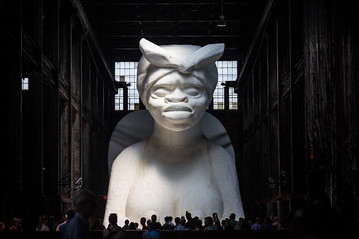
Molasses drips on the walls. Close to the entrance, leading to the altar and centerpiece of whiteness, brown sugar boys hold baskets as their faces and bodies melt in the heat. A few of them have collapsed on the floor, disintegrating into dark viscous puddles. And the onlookers who have come to the slavery fair to gawk and take pictures against a background of stark plantation pornography step over the fallen, with hardly a notice. But the sight of the fall and the reek of the demise linger.
Burnished baubles, they garnish and decorate the path to the huge, cool mammy presence at center-stage. White and glistening, big-lipped and bandanna-tied, she is exposed fore and aft, for the delight of any who care to visually fondle, pose, snap, and smile, and step up close into the intimacy of vicarious exploitation. She is the icon of American subservience, created out of and through dominance, its abject, undying figure. Sitting on her haunches, in perpetuity, she utters nary a mumble in protest. She does not see, but she is reverently and irreverently seen.
Mammy delicious is to be consumed, taken in with the eyes in a site of decay. As tall as the rafters, she perches in the Domino Factory, built by the water in Brooklyn in 1856, when slavery was profit central for an undivided nation, thrilled by blackface comics making darkie fun. The Domino game of domination erected an infrastructure of privilege, sucking up the goods and essence of the losers. The end of the Civil War did not stop slavery’s returns, which kept the mills churning, swelling the upper and middle classes and sweetening the world table. Even in its last days, the Domino factory belches out privilege and the diminishment and displacement of many for the delight and pleasure of some.
By now, you have figured it out. I am writing about the mammoth sugar and styrofoam mammy that Kara Walker is exhibiting in Brooklyn, under the title A Subtlety. This was the last weekend of its showing, and I, along with hundreds others, old and young, black, white, Asian, Latino, foreign, native, stood on an unending line for more than an hour to be in the company of this image of perverted motherhood that is readily available digitally.
The show is not just about seeing mammy minstrel and magnificent, but about seeing the self in her company. The show shares limelight with the spectator. Who comes? The families and friends cluster together, the crowds assemble and disassemble. How do they act? What do they do in relation to what is staged? When Kara Walker was making her early silhouettes, most of whom enjoyed the penetration of power, she was creating visual characters, flat yet stark. Now, with this three-dimensional work, her depictive power has grown, and moved off the wall into the hall. Mammy’s largeness is not just about the figure but about Mammy’s meaning n American life, not only then but also now, and we, the spectators, tell that current story as we position ourselves in mammy’s presence, cavorting and smiling on the floor and under the ceiling that the Havemeyers (loosely translated as the have-mores) of Domino wealth constructed.
Symbols and currencies abound. The Mammy symbol is magnified and so are the currency and fluidity of sugar that can occur in various forms: refined, raw, crude, brown, white, spirit-infused, and molten. The show’s penultimate day has meaning too. It is July 5, Independence plus one. Frederick Douglass, slavery’s virile icon of intelligence and independence, Mammy’s alter ego, when the Domino factory opened, has spoken of July 4, and why it has little meaning for him and for the men, women, and children of his blood who would not accommodate being mute statues in denigration’s gaze. Perhaps not so well known is that many of those in the arc of slavery’s stifling sweetness chose not to celebrate July 4, but honored the day following, July 5, instead.
So there I was in Brooklyn, on July 5, 2014, walking through the cavernous space that was also a cathedral of business complete with altar piece venerating sugar and slavery, practically a century and a half after slavery was signed away but refused to die. Instead, sugar sustained its future. And looming large in my eyes and in those of everyone else in attendance were these huge breasts of a pyramid beast woman, recast as reproductive machine. And she was made to suckle and perpetuate domination, to rebirth and sustain the sweetness of social differentiation and hierarchy.
I did not want to dwell long in the noxious smell of cloying sugar. Still, I did not regret coming. I had made the pilgrimage; I was seen and I saw, and I witnessed first-hand the Sphinx Mammy of empyrean whiteness. Even so, like the young brown boys, the Mammy Sphinx, despite her size, was fragile. Made of dissolvable stuff, she carried an expiration date, perhaps stamped on her hind parts or inside the voluptuous vulva. At the same time, she was enigmatic. And in those unending crowds, where was the Oedipus who could answer the riddle of the ages, while personally signifying the abomination of the mother, which is also slavery’s big sin and curse.


